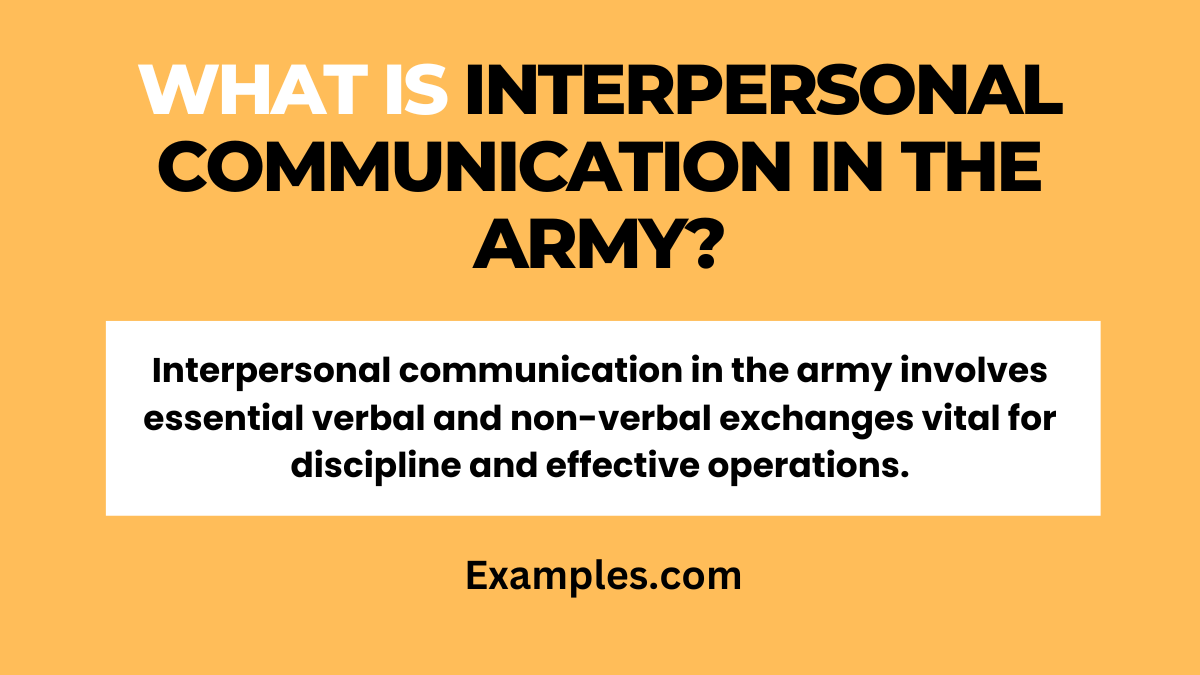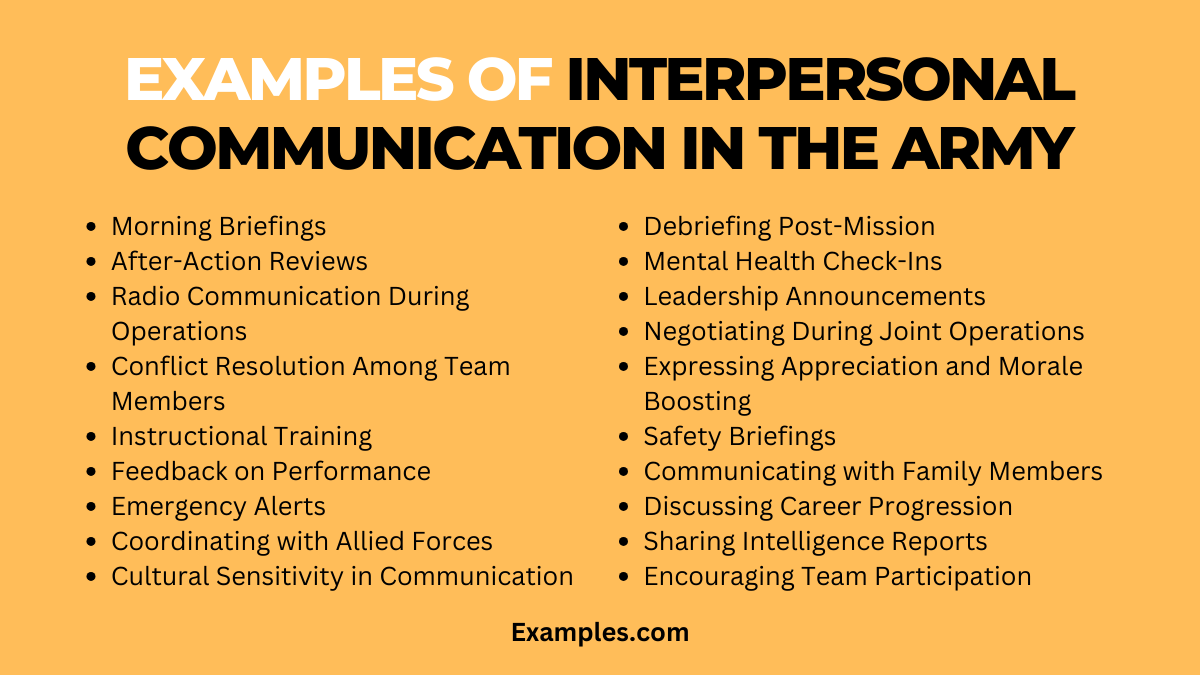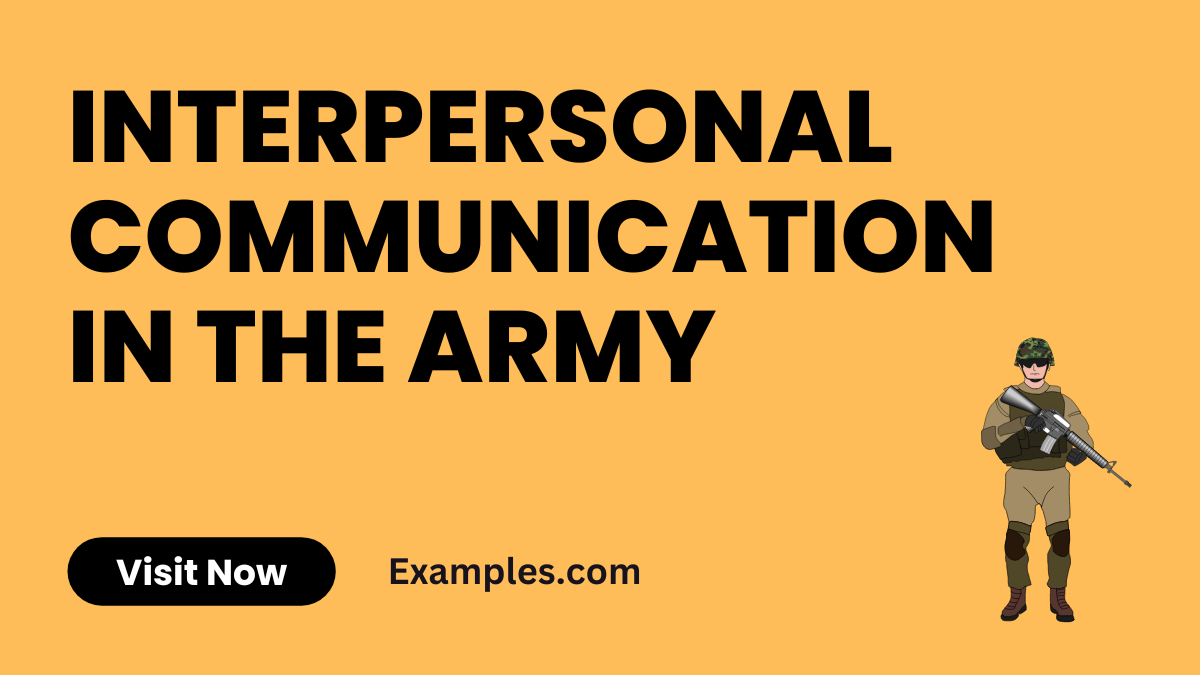19+ Interpersonal Communication in the Army Examples
Dive into the world of Interpersonal Communication in the Army with this comprehensive guide. Discover the nuances and importance of effective communication in military settings. Whether it’s through verbal instructions or non-verbal cues, mastering these skills is crucial for leadership, teamwork, and mission success. This guide offers vivid examples and practical tips, making it an indispensable resource for anyone looking to enhance their communication skills in the army.
What is Interpersonal Communication in the Army?

Interpersonal Communication in the Army refers to the exchange of information, feelings, and meanings between military personnel through verbal and non-verbal messages. It’s a multifaceted process that includes speaking, listening, observing, and understanding, critical for maintaining discipline, building camaraderie, and ensuring effective execution of military operations. Understanding this communication form is essential for successful leadership and team dynamics in the armed forces.
20 Examples of Interpersonal Communication in the Army

Interpersonal communication in the army is pivotal for operational success and team cohesion. It involves various forms of interaction, such as verbal, non-verbal, and written communication. Effective communication in the army ensures clear understanding, boosts morale, and supports the strategic goals of military operations. This article highlights 20 key examples of Interpersonal Communication in the army setting, each accompanied by a brief explanation and practical communication sentences. These examples encompass a wide range of scenarios, from daily briefings to critical mission discussions, demonstrating the diverse aspects of Interpersonal Communication in the Army.
- Morning Briefings:
- Explanation: Daily morning briefings are crucial for setting the day’s objectives and sharing vital information.
- Communication Example: “Today’s focus is on tactical drills. Ensure your equipment is ready by 0800 hours.”
- After-Action Reviews:
- Explanation: Conducting reviews after missions or exercises helps in evaluating performance and learning from experiences.
- Communication Example: “Let’s discuss what went well and where we need improvement from today’s drill.”

- Radio Communication During Operations:
- Explanation: Clear and concise radio communication is essential during operations for coordination and safety.
- Communication Example: “Bravo Team, move to checkpoint delta. Over.”
- Conflict Resolution Among Team Members:
- Explanation: Resolving interpersonal conflicts quickly and effectively is key to maintaining unit cohesion.
- Communication Example: “Let’s talk about what happened and find a way to work together more effectively.”
- Instructional Training:
- Explanation: Training sessions require clear, instructional communication to ensure skills are properly taught and understood.
- Communication Example: “This is how you dismantle and reassemble your weapon. Watch closely.”
- Feedback on Performance:
- Explanation: Providing constructive feedback helps soldiers improve their skills and performance.
- Communication Example: “Your shooting accuracy has improved, but let’s work on your reloading speed.”
- Emergency Alerts:
- Explanation: Quick and clear communication is vital in emergency situations for immediate response.
- Communication Example: “Red alert! All units to defensive positions now!”
- Coordinating with Allied Forces:
- Explanation: Collaborating with allied forces requires effective communication to ensure coordinated efforts.
- Communication Example: “Our team will secure the north sector while you move to the south.”
- Cultural Sensitivity in Communication:
- Explanation: Understanding and respecting cultural differences is important for international operations.
- Communication Example: “Be mindful of local customs when interacting with civilians in the area.”
- Debriefing Post-Mission:
- Explanation: Post-mission debriefs gather insights and lessons learned for future operations.
- Communication Example: “Let’s review the key outcomes and learnings from today’s mission.”
- Mental Health Check-Ins:
- Explanation: Regular check-ins on mental health foster a supportive environment and address any concerns.
- Communication Example: “How are you feeling after last week’s operation? It’s important to share.”
- Leadership Announcements:
- Explanation: Leaders communicate key decisions and updates to keep the team informed and aligned.
- Communication Example: “New policy changes will be implemented next week. Here’s what you need to know…”
- Negotiating During Joint Operations:
- Explanation: Effective negotiation skills are crucial during joint operations for mutual agreement and success.
- Communication Example: “We propose these terms for the joint operation. What are your thoughts?”
- Expressing Appreciation and Morale Boosting:
- Explanation: Positive reinforcement and appreciation help boost team morale and motivation.
- Communication Example: “Great job on the field today, team. Your hard work is truly appreciated.”
- Safety Briefings:
- Explanation: Safety briefings ensure that all team members are aware of protocols and potential hazards.
- Communication Example: “Remember, safety comes first. Always check your gear before deployment.”
- Communicating with Family Members:
- Explanation: Effective communication with family members is important for maintaining personal connections.
- Communication Example: “I’ll be away for training for the next two weeks but will stay in touch.”

- Discussing Career Progression:
- Explanation: Discussions about career progression help in planning and motivating for future roles.
- Communication Example: “Let’s talk about your career goals and how we can help you achieve them.”
- Sharing Intelligence Reports:
- Explanation: Sharing intelligence accurately and promptly is crucial for informed decision-making.
- Communication Example: “Latest intel suggests increased activity in the northern sector.”
- Encouraging Team Participation:
- Explanation: Encouraging everyone to participate in discussions fosters inclusivity and diverse perspectives.
- Communication Example: “I’d like to hear everyone’s input on this strategy.”
- Handling Sensitive Information:
- Explanation: Discreet and secure communication is essential when handling classified or sensitive information.
- Communication Example: “This information is confidential. Ensure it’s shared only with authorized personnel.”
Types of Interpersonal Communication in the Army
Interpersonal communication in the Army encompasses various forms, each critical for effective operations and leadership. The primary types include:
- Verbal Communication: Essential for giving orders, conducting briefings, and sharing information. Clarity and assertiveness are key.
- Non-Verbal Communication: Body language, facial expressions, and gestures play a significant role in conveying attitudes and emotions.
- Written Communication: Used for official documentation, orders, and reports. Accuracy and formality are crucial.
- Listening: Active listening skills are vital for understanding orders, feedback, and the needs of fellow soldiers.
- Visual Communication: Includes the use of visual aids, signals, and symbols, especially useful in combat or field operations.
- Emotional Expression: Understanding and managing emotions is essential in high-stress environments.
- Small Group Communication: Often used within squads or units for planning and coordination.
- Public Communication: Involves addressing larger groups, often for motivation or instruction.
- Digital Communication: Email, messaging, and other digital tools are increasingly important for coordination and information sharing.
- Interpersonal Conflict Communication: Handling conflicts effectively to maintain team cohesion and morale.
Elements of Interpersonal Communication in the Army
The elements of interpersonal communication in the Army are:
- Sender and Receiver: The individuals involved in the exchange of information.
- Message: The content of the communication, which can be verbal, non-verbal, or written.
- Channel: The medium used to convey the message, such as spoken words, written texts, or digital communication.
- Feedback: Responses or reactions to the message, crucial for understanding and adaptation.
- Context: The situation or environment in which communication occurs, which can significantly impact the interpretation and effectiveness of the message.
- Noise: Any interference that can distort or hinder the message, such as physical noise, language barriers, or emotional stress.
- Encoding and Decoding: The process of formulating a message and interpreting it, respectively.
Why is Interpersonal Communication Important in the Army?
Interpersonal communication is vital in the Army for several reasons:
- Effective Leadership: Leaders must communicate clearly to guide and motivate their teams.
- Operational Efficiency: Precise communication is crucial for the successful execution of missions and operations.
- Team Cohesion: Good communication fosters trust, understanding, and teamwork.
- Decision Making: Accurate and timely information exchange is essential for making informed decisions.
- Conflict Resolution: Effective communication helps in resolving disputes and maintaining morale.
What Army Regulation Covers Interpersonal Communication?
- Regulation Documentation: The Army’s regulation on interpersonal communication is meticulously documented. These documents provide guidelines on how the personnel should engage in interpersonal interactions, considering the diverse settings they may encounter.
- Scope of Regulation: The regulation covers various types of interpersonal communication, such as verbal, non-verbal, and written. This includes aspects like tone, clarity, brevity, and respectfulness in communication.
- Training and Implementation: Army personnel receive comprehensive training in interpersonal communication. This training is designed to enhance their ability to communicate effectively in different situations, ranging from daily operations to high-pressure environments.
- Adaptability and Cultural Sensitivity: The regulations also emphasize adaptability and cultural sensitivity in communication, which is crucial for operations in diverse global contexts.
- Feedback and Continuous Improvement: Continuous feedback and improvement are integral to the Army’s approach. Regular assessments ensure that the communication standards are upheld and adapted to changing environments and requirements.
- Digital Communication Standards: In today’s digital age, the regulation also extends to digital platforms, ensuring secure and clear communication across various digital channels.
- Conflict Resolution: Guidelines for handling interpersonal conflict communication are also a part of the regulation, emphasizing conflict resolution and maintaining morale.
- Confidentiality and Security: The Army regulation also stresses the importance of confidentiality and security in interpersonal communication, especially concerning sensitive information.
- Record Keeping and Reporting: Proper documentation and reporting of communications are also covered under these regulations, which is essential for accountability and historical record-keeping.
- Compliance and Enforcement: Compliance with these regulations is mandatory, and enforcement mechanisms are in place to ensure adherence to these communication standards.
Incorporating the keywords Interpersonal Communication in the Army and Elements of Interpersonal Communication, this guide offers an overview of the types, elements, importance, and regulatory framework of interpersonal communication in the Army, catering to the needs of those seeking comprehensive and SEO-friendly content.



